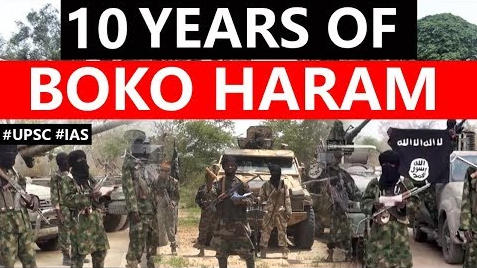Table of Contents
INTRODUCTION
- Nigeria has witnessed several insurgencies from tribal militias in its 59-year modern history.
- But it was the emergence of Boko Haram that altered the nature of violence.
- Over the decade, Boko Haram has spread from northeast Nigeria to neighbouring West African nations of Niger, Chad and Cameroon in the Lake Chad Basin.


HISTORY OF BOKO HARAM
- In the 2000s, Boko Haram emerged in Nigeria as a small Sunni Islamic sect advocating a strict interpretation and implementation of Islamic law.
- The group, officially called Jama’a Ahl as-Sunna Li-da’wa wa-al Jihad, is more commonly known as Boko Haram, a nickname given by the country’s local Hausa-speaking population.
MOHAMMED YUSUF
- Around 2002, a Nigerian Muslim sect leader, Mohammed Yusuf set up an Islamic school and a mosque in Borno state of Nigeria.
- Spoke openly against corruption and police violence in Nigeria
- This made people sympathetic to his cause against the establishment.
A BIG MISTAKE
- In 2009, Boko Haram launched a rebellion against the Nigerian government.
- It was quashed and Yusuf was taken into custody and killed.
- Women and children were also subjected to torture, and many were killed by the police while in custody.
- Nigerian government believed that they had controlled the uprising.
- Consequently, members of Boko Haram declared war on Nigerian authorities.
- Boko Haram became radicalised after Yusuf’s death.
- A year later, one of his lieutenants, Abubakar Shekau announced that he was the new leader of Boko Haram.
- Later the violence continued due to the failure of the Nigerian government, until the group gained international attention by kidnapping 300 school girls in Chibok.

ABDUCTION OF NIGERIAN SCHOOL GIRLS
- In April 2014, approximately 276 school girls at the Girls’ Secondary School in the town of Chibok in Borno state were asleep in their boarding school dormitories when armed men from Boko Haram kidnapped them.
- Nigeria did not begin rescue efforts immediately and that gave Boko Haram enough time to hide the girls.
- The abduction led to global outrage and put Boko Haram in the international spotlight like never before.

FORCES STRUGGLE TO CONTROL BOKO HARAM
- The group operated in a vigorous, organized manner.
- Nigerian armed forces were poorly armed in comparison with Boko Haram.
- Boko Haram had intimate knowledge of the area and was able to infiltrate the communities.
- By the time the government put up a serious fight, Boko Haram was already well-entrenched.
STRUGGLE CONTINUED
- Initially, Nigeria had rejected assistance from Britain, France and the US in retrieving the abducted girls.
- Months of negotiations by various government and private parties took place with Boko Haram leaders to free the girls.
- By the time Muhammadu Buhari became president of Nigeria in 2015, Boko Haram had split into separate factions and the girls had been divided among them.
- As of 2019, 112 girls remain in captivity.
SPLIT IN BOKO HARAM
- After losing ground to the Nigerian military forces in 2015, Boko Haram’s Abubakar Shekau pledged loyalty to Abu Bakr alBaghdadi, leader of the Syria/Iraq-based ISIS.
- But ISIS was planning establish its independent presence in West Africa.
- In 2016, it did just that by creating the Islamic State West Africa province (ISWA, also known as ISWAP), under the leadership of Abu Musab Al-Barnawi (son of Boko Haram founder, Mohammed Yusuf).

PRESENT SCENARIO
- Now the world has to deal with 2 terror groups operating in the same region.
- But experts believe that it is too soon to say whether ISIS will be able to expand in larger west Africa.
- There is much still unknown about these groups and their plans, capacity and resources.
Latest Burning Issues | Free PDF






















 WhatsApp
WhatsApp